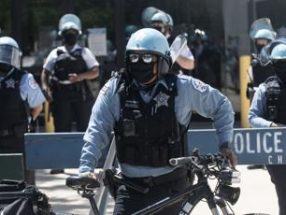When the Illinois State Legislature passed the Safety, Accountability, Fairness and Equity-Today Act (SAFE-T Act) in 2021 after a year of widespread civil unrest following the murder of George Floyd, longtime reform advocates cheered provisions of the omnibus bill that brought major changes to policing practices and more robust accountability mechanisms for serious police misconduct.
And although the bill’s pretrial detention reform eliminating cash bail shows early signs of success since going into effect last fall after numerous legal challenges, the impact of the policing reforms has been more measured, according to a recent set of policy briefs published by Impact for Equity, a public interest, legal nonprofit.
Broken down into three categories, the briefs studied the policing reforms included in the bill: the widespread adoption of body-worn cameras, a revised officer decertification system, and updated, more stringent standards around when officers can legally use force.
But, according to Loren Jones, the criminal legal system director at Impact for Equity and the co-author of one of the briefs, implementation of those reforms has been “uneven,” with some departments “lagging” behind.
“Without an accountability mechanism that ensures implementation is happening and is robust, a lot of these things are piecemeal and very slow to implement,” she said.
An added hurdle, Jones said, is that with more than 370 law enforcement agencies across the state and no agency set up to oversee the SAFE-T Act’s implementation, it becomes extremely onerous to assess each department’s compliance with the law.
“It does require law enforcement agencies to embrace this change,” she said, “and we’re seeing resistance” from them.
Indeed, law enforcement agencies’ lobbyists in Springfield have not shied away from trying to convince lawmakers to undo certain elements of the reforms, Jones said. This includes allowing officers to appeal the automatic decertification process even if they are convicted of one of the enumerated felonies and repealing the prohibition against officers shooting people in the back with rubber bullets.
“So far, they haven’t been very successful, but that’s because there are advocates paying attention,” she said. “It’s like any other policing issue, we just have to keep the focus there and make sure that additional protections are not getting rolled back.”
One of the briefs found that nine out of 10 Illinois law enforcement agencies surveyed had failed to fully bring their use of force policies into line with the new state standards. Several, according to the brief, did not establish policies that mandate officers’ duty to intervene if witnessing a colleague using excessive force, despite that being required by the new law. (Jones said that the Chicago Police Department (CPD), which last updated its use of force policy in 2020, was the one agency in full compliance.)
Another brief showed that although more officers are being decertified since the SAFE-T made convictions for several misdemeanor crimes associated with domestic violence subject to automatic decertification, the promised discretionary hearings for officers accused of other forms of police misconduct have yet to get underway despite more than 400 complaints made to the state certification board in 2023 and the new certification review panel being sufficiently staffed.
Additionally, a promised public dashboard detailing officer misconduct investigations isn’t available, the brief found.
Keith Calloway, executive director of the Illinois Law Enforcement Training and Standards Board, which oversees the certification review panel and the public dashboard, said in a statement that the board continues "to hire qualified administrative staff and lawyers and train our appointed panel to evaluate cases, while also completing the majority of the mandates we are responsible for implementing."
"Our priority is to launch this the right way from day one, which is why we’ve engaged a range of partners in this work to ensure it is done thoughtfully and correctly,” Calloway added.
A third brief assessing the CPD’s use of body worn cameras discovered that officers who don’t activate their cameras as required by departmental policy aren’t being subject to meaningful discipline and that supervisors are failing to monitor the footage associated with use of force reports.
“A (disciplinary) plan is only considered at the fifth time (officers) fail to comply with the body worn camera policy,” Jones said. “The policy even reflects this sort of lackadaisical view on how important it is to have that camera on.”
That brief also found that the department often fails to accurately label and store footage, undermining “the overall integrity of the City’s police accountability system.”
CPD did not respond to the Herald’s request for comment as of press time, June 10.
Alexander Perez, a member of the 2nd District Police Council, a democratically elected police accountability body representing the Hyde Park-Kenwood as well the Bronzeville and Washington Park neighborhoods, said that while he was disturbed by the brief’s findings about CPD’s compliance with its own body worn camera policies, he wasn’t surprised.
“I’m not shocked given the history that CPD has with transparency, accountability, and trying to adhere to policy and standards,” he said. “From a district council standpoint, this is definitely something we need to be talking about.”
Local state Senator Robert Peters (D-13th), one of the foremost proponents of the SAFE-T Act, agreed with Jones that ensuring policing agencies fully comply with the law still faces hurdles.
“It is consistently disheartening that as we are trying to improve public safety standards, such as having bodywork cameras for transparency’s sake, it always seems to be an uphill battle,” he said.
Peters noted, however, that the law provides for a January 2025 implementation target date, and because the fight over the pre-trial reform eliminating cash bail has finally ended, he thinks advocates can now return their attention to addressing policing.
“Reforming the police has been and is one of the most difficult things we can do, but I do think that there are people, even in policing, who are trying to make it better,” he said. “Let’s see if we get these stakeholders together if we can finally bring some real public safety for everybody.”


